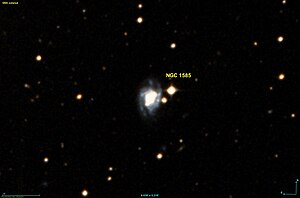NGC 1585
| Galaxy NGC 1585 |
|
|---|---|

|
|
| AladinLite | |
| Constellation | Digger |
|
Position equinox : J2000.0 , epoch : J2000.0 |
|
| Right ascension | 04 h 27 m 33.0 s |
| declination | -42 ° 09 ′ 55 ″ |
| Appearance | |
| Morphological type | SA: (s) bc |
| Brightness (visual) | 13.5 likes |
| Brightness (B-band) | 14.2 mag |
| Angular expansion | 1.2 ′ × 0.7 ′ |
| Position angle | 175 ° |
| Surface brightness | 13.2 mag / arcmin² |
| Physical data | |
| Redshift | 0.015534 +/- 0.000103 |
| Radial velocity | 4657 +/- 31 km / s |
|
Stroke distance v rad / H 0 |
(201 ± 14) · 10 6 ly (61.6 ± 4.3) Mpc |
| history | |
| discovery | John Herschel |
| Discovery date | December 6, 1834 |
| Catalog names | |
| NGC 1585 • PGC 15150 • ESO 303-018 • MCG -07-10-006 • IRAS 04259-4216 • 2MASX J04273300-4209549 • SGC 042555-4216.5 • GALEXASC J042732.96-420953.3 • LEDA 15150 | |
NGC 1585 is a spiral galaxy of Hubble type Sc in the constellation Caelum the southern sky . It is estimated to be 201 million light years from the Milky Way and about 70,000 light years across .
The galaxy IC 2068 is located in the same area of the sky .
The object was discovered by John Herschel on December 6, 1834 .
